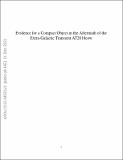| dc.contributor.author | Pasham, Dheeraj R | |
| dc.contributor.author | Ho, Wynn CG | |
| dc.contributor.author | Alston, William | |
| dc.contributor.author | Remillard, Ronald | |
| dc.contributor.author | Ng, Mason | |
| dc.contributor.author | Gendreau, Keith | |
| dc.contributor.author | Metzger, Brian D | |
| dc.contributor.author | Altamirano, Diego | |
| dc.contributor.author | Chakrabarty, Deepto | |
| dc.contributor.author | Fabian, Andrew | |
| dc.contributor.author | Miller, Jon | |
| dc.contributor.author | Bult, Peter | |
| dc.contributor.author | Arzoumanian, Zaven | |
| dc.contributor.author | Steiner, James F | |
| dc.contributor.author | Strohmayer, Tod | |
| dc.contributor.author | Tombesi, Francesco | |
| dc.contributor.author | Homan, Jeroen | |
| dc.contributor.author | Cackett, Edward M | |
| dc.contributor.author | Harding, Alice | |
| dc.date.accessioned | 2022-03-31T14:34:22Z | |
| dc.date.available | 2022-03-31T14:34:22Z | |
| dc.date.issued | 2022-02 | |
| dc.identifier.uri | https://hdl.handle.net/1721.1/141438 | |
| dc.description.abstract | The brightest Fast Blue Optical Transients (FBOTs) are mysterious
extragalactic explosions that may represent a new class of astrophysical
phenomena. Their fast time to maximum brightness of less than a week and
decline over several months and atypical optical spectra and evolution are
difficult to explain within the context of core-collapse of massive stars which
are powered by radioactive decay of Nickel-56 and evolve more slowly. AT2018cow
(at redshift of 0.014) is an extreme FBOT in terms of rapid evolution and high
luminosities. Here we present evidence for a high-amplitude quasi-periodic
oscillation (QPO) of AT2018cow's soft X-rays with a frequency of 224 Hz (at
3.7$\sigma$ significance level or false alarm probability of 0.02%) and
fractional root-mean-squared amplitude of >30%. This signal is found in the
average power density spectrum taken over the entire 60-day outburst and
suggests a highly persistent signal that lasts for a billion cycles. The high
frequency (rapid timescale) of 224 Hz (4.4 ms) argues for a compact object in
AT2018cow, which can be a neutron star or black hole with a mass less than 850
solar masses. If the QPO is the spin period of a neutron star, we can set
limits on the star's magnetic field strength. Our work highlights a new way of
using high time-resolution X-ray observations to study FBOTs. | en_US |
| dc.language.iso | en | |
| dc.publisher | Springer Science and Business Media LLC | en_US |
| dc.relation.isversionof | 10.1038/s41550-021-01524-8 | en_US |
| dc.rights | Creative Commons Attribution-Noncommercial-Share Alike | en_US |
| dc.rights.uri | http://creativecommons.org/licenses/by-nc-sa/4.0/ | en_US |
| dc.source | arXiv | en_US |
| dc.title | Evidence for a compact object in the aftermath of the extragalactic transient AT2018cow | en_US |
| dc.type | Article | en_US |
| dc.identifier.citation | Pasham, Dheeraj R, Ho, Wynn CG, Alston, William, Remillard, Ronald, Ng, Mason et al. 2022. "Evidence for a compact object in the aftermath of the extragalactic transient AT2018cow." Nature Astronomy, 6 (2). | |
| dc.contributor.department | MIT Kavli Institute for Astrophysics and Space Research | |
| dc.relation.journal | Nature Astronomy | en_US |
| dc.eprint.version | Author's final manuscript | en_US |
| dc.type.uri | http://purl.org/eprint/type/JournalArticle | en_US |
| eprint.status | http://purl.org/eprint/status/PeerReviewed | en_US |
| dc.date.updated | 2022-03-31T14:17:45Z | |
| dspace.orderedauthors | Pasham, DR; Ho, WCG; Alston, W; Remillard, R; Ng, M; Gendreau, K; Metzger, BD; Altamirano, D; Chakrabarty, D; Fabian, A; Miller, J; Bult, P; Arzoumanian, Z; Steiner, JF; Strohmayer, T; Tombesi, F; Homan, J; Cackett, EM; Harding, A | en_US |
| dspace.date.submission | 2022-03-31T14:17:48Z | |
| mit.journal.volume | 6 | en_US |
| mit.journal.issue | 2 | en_US |
| mit.license | OPEN_ACCESS_POLICY | |
| mit.metadata.status | Authority Work and Publication Information Needed | en_US |
